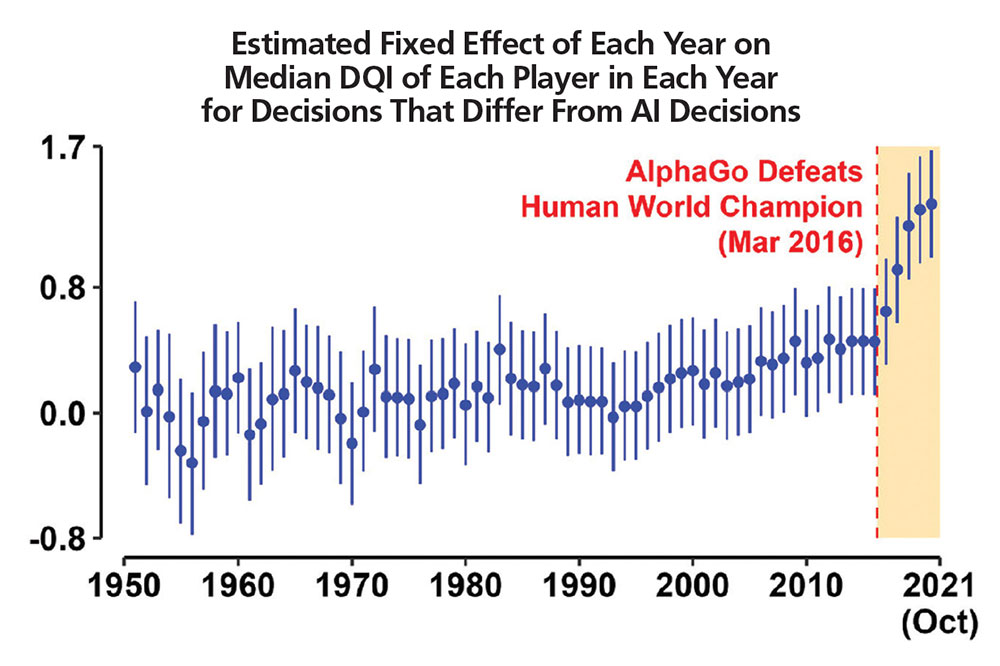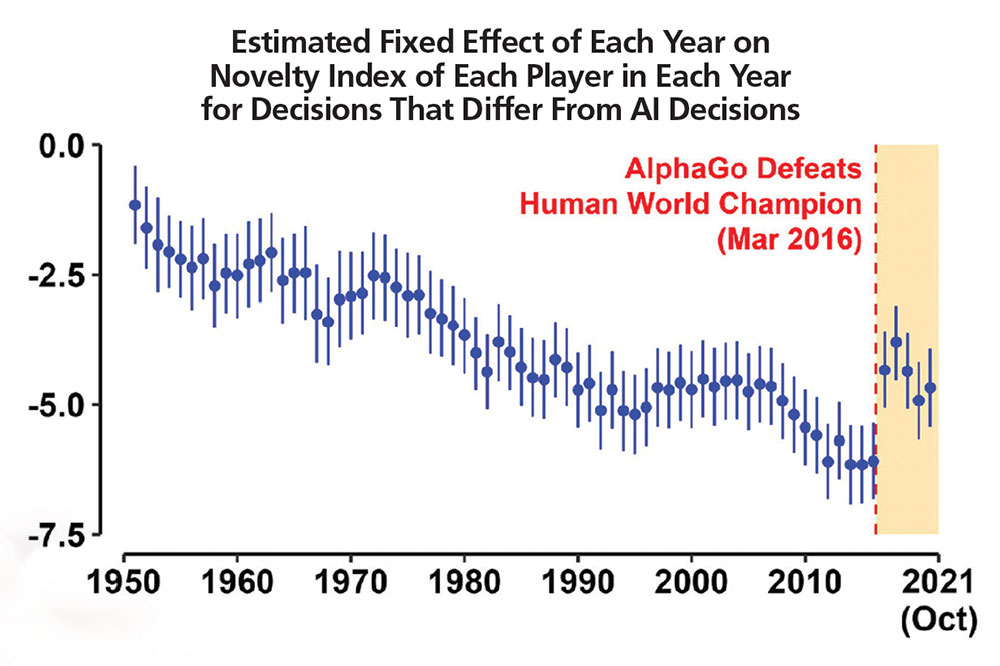Professor Minkyu Shin
Assistant Professor
Department of Marketing
Professor Minkyu Shin of the Department of Marketing analyses the potential for superhuman AI in the context of the
ancient game of Go and finds that it can prompt us to break away from traditional strategies and act as a catalyst for
human innovation.
In an era marked by rapid technological evolution, artificial intelligence is no longer a concept restricted to the realms
of science fiction. Instead, it has become an integral part of our daily life, transforming the way we work, socialise,
learn, and make decisions. One particular area where AI's influence is profoundly felt is in decision-making, especially in
complex environments that demand strategic thinking and foresight. But how exactly does AI influence human decisionmaking?
And what are the implications of this influence on our professional and personal lives?
The advent of superhuman AI
Before we delve into the specifics, it's crucial to clarify what we mean by "superhuman AI." This term refers to AI
systems that have the ability to outperform human experts in specific tasks or fields. Unlike traditional computational
tools such as simple calculators or basic computers which are primarily designed to execute specific tasks based on
predefined rules, superhuman AI systems are capable of learning, adapting, and making decisions that can outperform
those made by humans.
Take the game of chess, for instance. Traditional computer programmes such as early versions of chess-playing software
operate by following a set of predefined rules and algorithms. They can calculate thousands of potential moves and
outcomes, but they are fundamentally limited by their programming and cannot adapt to novel situations or devise new
strategies.
On the other hand, superhuman AI systems like Google's AlphaZero can teach themselves to play chess at an extremely
high level by playing millions of games against themselves and learning from their mistakes. They can discover and
implement novel strategies that human players, including grandmasters, may never have considered.
Another compelling example of superhuman AI in action can be found in the realm of natural language processing,
a field that significantly influences our daily interactions and communications. Traditional chatbots work based on
predetermined scripts and keyword recognition. They are limited to responding to specific prompts and often fail to
understand or generate meaningful responses to unexpected queries. Their capability is akin to a basic calculator or
computer, executing predefined tasks reliably but lacking the ability to learn, adapt, or think creatively.
In contrast, GPT models like OpenAI's ChatGPT represent an evolution in this technology. Trained on vast amounts of text
data from the internet, these models can generate coherent and contextually appropriate responses to a wide range of
prompts. They can grasp the nuances of language, understand complex queries, and even exhibit a degree of creativity
in their responses. For instance, they can draft emails, write essays, answer factual questions, and even generate
poetry or fiction. What sets ChatGPT apart is the ability to unearth hidden patterns in the data they've been trained on
and generate novel responses based on those patterns. This is not unlike identifying a winning strategy in a game or
uncovering a new theory from a dataset in scientific research.
Our research question: Can humans learn from "black box" superhuman AI?
The capability of superhuman AI to unearth hidden patterns and devise new rules or strategies indeed has
profound implications for human decision-making. This suggests that humans can learn from these AI systems
to improve their own decision-making processes. This could be applied in various contexts, whether that involves
devising a winning move in a board game, making a critical business decision, or diagnosing a complex medical
condition.
However, achieving this level of performance isn't always straightforward. To reach superhuman capabilities, AI systems
often need to delve very deeply into their respective tasks, which can sometimes come at the cost of interpretability.
For instance, consider the workings of a deep neural network used for image recognition. These AI systems can
identify objects, faces, and even subtle signs of disease in medical images with superhuman accuracy. However, the
internal workings of these AI systems – the way they weigh and combine countless variables to reach a decision –
can be incredibly complex and difficult for humans to understand. This is often referred to as the "black box"
problem in AI.
In such scenarios, where superhuman AI systems are often designed without a focus on helping human decision-makers
understand their output, it prompts us to question: can we still argue that superhuman AI brings advancement in human
decision-making? And what could be a potential mechanism?
Result 1: Human players in the
game of Go get better after
AlphaGo.
Our research, carried out over the
span of 71 years and involving analysis
of more than 5.8 million strategic
decisions, delves into these questions.
We focused on the ancient game of
Go, a domain where AI, specifically
superhuman AI such as AlphaGo, has
already surpassed human performance.
Our findings shed light on the
interplay between AI and human
decision-making, and hint at powerful
implications for businesses, education,
and even societal norms.
In our research, we used a superhuman
AI programme to assess the quality of
human decisions in the game of Go. By generating 58 billion counterfactual game patterns, we compared the win rates
of actual human decisions with those of counterfactual AI decisions. What we discovered was quite intriguing. In the era
following the advent of superhuman AI (i.e., AlphaGo), human players began to make significantly better decisions. This
observation leads to a fascinating question: what could be the mechanisms driving this improvement?
Result 2: Human players have
started making more novel
move decisions since AlphaGo's
introduction.
Upon analysing human players'
strategies across time, we found that
the introduction of superhuman AI also
coincided with an increase in novel
decisions. In other words, moves that
had never been observed before started
occurring more frequently. What's
more, these novel decisions were
associated with higher decision quality,
indicating that they weren't simply
random but strategically advantageous.
This points toward a fascinating
phenomenon. The development of
superhuman AI programmes may have prompted human players to break away from traditional strategies and explore
new, innovative moves. This exploration, in turn, appears to have improved their decision-making.
Despite AlphaGo and related systems not being explicitly designed to enable human players to understand its decisionmaking
process, it has inadvertently become a tool for human advancement in the game of Go. Its unconventional
and superior strategies have pushed human players to reconsider their traditional gameplay and experiment with new
approaches. By observing and adapting the AI's outputs, players have been able to devise novel strategies, leading to
a significant improvement in their decision-making quality. Thus, although AlphaGo may operate as a "black box," its
influence has sparked progress and innovation amongst human players.
"Superhuman AI is more
than just a tool for improving
efficiency or automating tasks.
It is a catalyst for human
innovation"
Everyday applications and impacts
While our research focused on the game of Go, its implications extend far beyond this specific context. At its core,
decision-making is a universal process, applicable in a multitude of situations from everyday choices to complex business
strategies.
In business scenarios, for instance, this could mean that AI systems could stimulate human managers to break away
from traditional, time-honoured strategies and explore novel, more effective approaches. This could lead to innovative
breakthroughs, allowing companies to gain competitive edges or solve previously intractable problems.
In educational settings, AI could foster a culture of innovation and creativity among learners. By providing insights which
challenge traditional thinking, AI tools could encourage learners to explore uncharted territories in their respective fields,
thereby enhancing their problem-solving skills and broadening their perspectives.
Concluding remarks
Our research offers a glimpse into the intricate dynamics between superhuman AI and human decision-making.
It highlights how AI, a creation of human intellect, can in turn stimulate human intellect to reach new heights. By
catalysing novelty and innovation, superhuman AI can be a powerful ally in our quest for progress, opening up new
vistas of possibilities in various domains.
It is important to remember, however, that this is just the beginning. As AI continues to evolve and becomes even more
integrated into our lives, its influence on human decision-making could also evolve in ways we cannot fully anticipate
today. Nevertheless, our findings suggest a promising trajectory, one where AI and humans can co-evolve, each pushing
the other toward greater heights of innovation and decision-making prowess.
In conclusion, superhuman AI is more than just a tool for improving efficiency or
automating tasks. It is a catalyst for human innovation, a spark that can ignite the
flame of creativity and decision-making excellence. As such, understanding its
influence on human decision-making is not just an academic pursuit - it is a quest
to understand the future trajectory of human potential itself.
Reference:
https://www.pnas.org/doi/10.1073/pnas.2214840120



